Plasticity of Vision: Ben Okri’s Famished Road Cycle
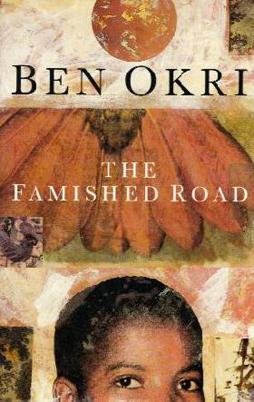 Ben Okri’s 1991 novel The Famished Road won the Booker Prize and was followed in 1993 by Songs of Enchantment and in 1998 by Infinite Riches. Riches called itself “Volume Three of The Famished Road cycle,” which seems an apt term. The books individually are visionary accomplishments, filled with ecstatic and elegant prose; and they are concerned with cycles, of lives and stories. They are concerned with myth, and themselves create myth, a mythology of history or at least a mythology intersecting with history.
Ben Okri’s 1991 novel The Famished Road won the Booker Prize and was followed in 1993 by Songs of Enchantment and in 1998 by Infinite Riches. Riches called itself “Volume Three of The Famished Road cycle,” which seems an apt term. The books individually are visionary accomplishments, filled with ecstatic and elegant prose; and they are concerned with cycles, of lives and stories. They are concerned with myth, and themselves create myth, a mythology of history or at least a mythology intersecting with history.
They follow Azaro, whose name is short for ‘Lazarus.’ He is an abiku, a spirit child, in what appears to be pre-independence Nigeria (the country where the books take place are never named). Abiku, we are told, are supposed to be born many times, dying young repeatedly; Azaro has decided to stay in this world, but can see spirits and in fact remembers his existence before birth. His friends in the spirit world remember him, too, and want him back. The first book in particular revolves around his determination to stay with the family into which he has been born, and his desire to make his mother happy. The second book, as Azaro himself observes, changes focus; it is less about his struggles with the other world, as his spirit friends change tack: “They chose to draw me deeper into the horrors of existence as a way of forcing me to recoil from life.” The focus here moves away from Abiku, toward his parents and his ghetto community; by the third book we are caught up in their myth, following their story as it moves on toward the end of its cycle.
The books are about, among other things, story and history and the ending of one cycle in a people’s existence and the beginning of a new. They are about the creation of a new nation. Are they fantasies? I suppose it’s mostly possible to read them as realistic — to see Azaro as delusional, to dismiss all the myths and visions as unreal. I am wildly skeptical that such an approach would produce any useful understanding of the books. On the other hand, these books are involved with myth as opposed to the kind of writing normally described by the word “fantasy.” Personally, I’d describe them as fantasies because to me “fantasy” includes the visionary — which these books are, 1990s equivalent to the prophecies of William Blake. It’s fair to argue that I’m getting those words backwards, that fantasy is a subspecies of the visionary instead of the reverse; but I think that “fantasy” perhaps also implies the kind of creative response demanded here of readers. As I said, I don’t think approaching these books with a perspective that privileges the realistic will get very far. Whatever world you use for them, it’s worth acknowledging that these are books of myth that call out to the mythic sensibility.
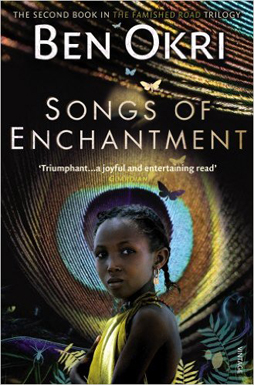 Not to belabour the point, but you can also reverse things. You can say that by describing The Famished Road cycle as fantasy you hallow the word “fantasy.” You restore, or at least insist on, a wildness and potency within that word. You insist on the value of fantasy: on the range of meanings it can cover. The books are fictions that attempt to approach the numinous through unreal imagery.
Not to belabour the point, but you can also reverse things. You can say that by describing The Famished Road cycle as fantasy you hallow the word “fantasy.” You restore, or at least insist on, a wildness and potency within that word. You insist on the value of fantasy: on the range of meanings it can cover. The books are fictions that attempt to approach the numinous through unreal imagery.
It’s possible to argue that the books defy the distinction between the fantastic and the mimetic. But then again it may be useful to be able to approach the books from either angle, not locked into one exclusively: to see the wonder and myth, but also to see the history in them, to understand them as stories about a specific place and time, about people living their lives through story as well as through poverty, living story as an imaginative alternative to poverty. Perhaps again the use of having that kind of double vision is that it can lead one to a unity: to see that in the end they’re all one.
What I’m trying to talk about in this discussion of terminology is the way of experiencing the stories. The books become less and less focussed on narrative as they move along; events become springboards for Azaro’s visions, which become longer and more encyclopedic, incorporating other times, other lives, and faraway places. By the end of the third book we realise that they are consciously universal, all-encompassing, speaking not just about one place or time but about all times and all places, about all the world. The mythic aspects, the visionary aspects, predominate.
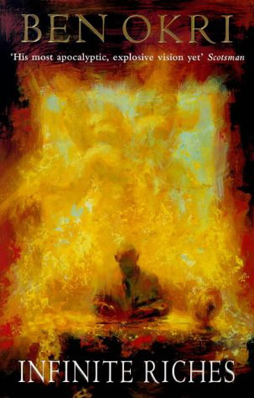 It is difficult even to describe the variety of imagery in these visions. Ghosts of all sorts, the human form stretched and distorted. Natural animals like antelopes and lions made strange, given gemstone eyes or other features. Roads, perhaps especially: hungry closed roads, and the promising open roads of stories. There is an infinite variety to the spirits that wander through the books, a plasticity that makes me think of Miyazaki: unexpected images that always feel right.
It is difficult even to describe the variety of imagery in these visions. Ghosts of all sorts, the human form stretched and distorted. Natural animals like antelopes and lions made strange, given gemstone eyes or other features. Roads, perhaps especially: hungry closed roads, and the promising open roads of stories. There is an infinite variety to the spirits that wander through the books, a plasticity that makes me think of Miyazaki: unexpected images that always feel right.
The plot grows more slender as the books go on. They tell their story through archetypes and recurring patterns of incident. Azaro’s parents, only ever identified as Mum and Dad, are examples of this archetype — they’re all our parents, our ideal parents, with a physically powerful father and a caring mother who supports her family. The other characters are hardly less universal, particularly a sinister old blind wizard, and a photographer who seems to incarnate modernity and perhaps modern media. Madame Koto is perhaps the most prominent character outside of Azaro’s family, in a sense the main character of the books: she begins as the owner of a local bar, and we follow the birth and growth and demise of her myth as she becomes involved in politics and becomes an enchantress and something like a goddess.
In other words, even outside of Azaro’s visions the cycle is highly symbolic. By the end of the book it’s no surprise to find ourselves reading about a dead carpenter in a white suit. The symbols become more prominent as the books go along, while also becoming more political and perhaps more cosmological. We see certain things happen again and again. Azaro runs away from his family. His father, an amateur boxer who fights under the heroic and Blakean name Black Tyger, gets in a fight and is battered but victorious (it should not be overlooked that these fight scenes are well-structured and involving). Azaro’s mother rescues one or both of her family. Even Madame Koto’s cars are crashed twice.
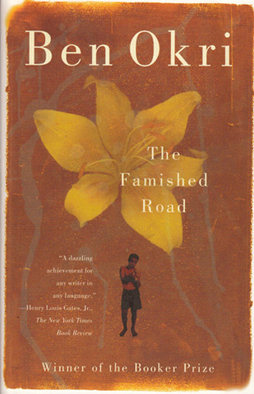 Of the three books, The Famished Road has perhaps the most traditionally novelistic sense of character, introducing Azaro and his family and their ghetto. The title has a number of meanings. We see how poverty breeds hunger. But also we see the power of roads, as the book opens in the spirit world with a river that becomes a road. Azaro’s father tells him of a hungry giant who existed before the first road, and becomes part of it. The road becomes a symbol of development, of modernity, of change.
Of the three books, The Famished Road has perhaps the most traditionally novelistic sense of character, introducing Azaro and his family and their ghetto. The title has a number of meanings. We see how poverty breeds hunger. But also we see the power of roads, as the book opens in the spirit world with a river that becomes a road. Azaro’s father tells him of a hungry giant who existed before the first road, and becomes part of it. The road becomes a symbol of development, of modernity, of change.
Songs of Enchantment perhaps more thoroughly fuses visions with politics. Which is to say that politics, the clash between “the Party of the Rich” and “the Party of the Poor,” becomes a clash of mythologies. The book is therefore consciously about stories, and here the river-road becomes an image for story — so the central images of one book are broadened and deepened in others. In concrete terms Azaro’s Dad becomes the central figure, turning into a visionary, getting involved in politics, and performing a redemptive act that closes the book. The movement of the book is surprising: Okri develops a sinister figure, the Masquerade, as a kind of embodiment of disharmony and wrongness, indeed a summation of the various malevolences that have appeared in the cycle thus far — but there is no struggle against it. It’s not clear it really can be fought. Azaro’s own visions testify to its necessity. It simply presents challenges that must be met.
Among those challenges is the shrinking of the forest, a kind of traditional spiritual heart; the locus of vision, from which spirits emerge (I cannot help here but think of Amos Tutuola’s otherworld of spirits, also located in the forest). The forest is cut down that roads may be built, emphasising the ambiguity of the road as a symbol. The development’s done at the behest of foreign and colonial authorities, which give Infinite Riches a focus. The title actually appears in the text, with fine irony, in a piece of writing by a colonial administrator who later finds it cut from the printed text of his memoirs. The riches are the riches of the human spirit, which is infinite only when truly global; only when all the riches created by all the nations of the world are understood. Thus this is the most cosmic of the books, and most universal, yet also situated the most within history. It is a story of dreams, of history and the way history is rewritten. It is Madame Koto’s story, the story of her myth, and the story of the ending (or at least an ending) of myth and an entrance into history.
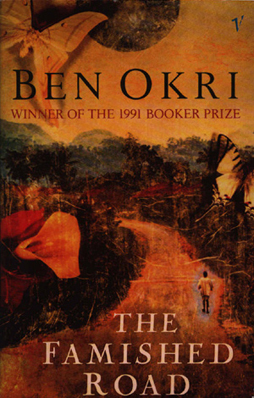 The books are exhausting and invograting. They both oppose and fuse the world of vision and the world of everyday life. There is poverty and there is myth and while the two things are not the same neither are they separate. Myth and vision are not escapism or consolation among poverty, but a way into a world of meaning. Everyone, no matter how poor, has myth: has the power to see their life as prophetically inspired. If they choose to.
The books are exhausting and invograting. They both oppose and fuse the world of vision and the world of everyday life. There is poverty and there is myth and while the two things are not the same neither are they separate. Myth and vision are not escapism or consolation among poverty, but a way into a world of meaning. Everyone, no matter how poor, has myth: has the power to see their life as prophetically inspired. If they choose to.
Myths here are made by human action. Among the mythic cycles within the overall Famished Road cycle are the Madame Koto cycle and the Azaro’s Dad cycle; in both cases we see them begin and develop and, in at least the first case, end. They’re myths of power and action, of how to handle oneself in the world. Black Tyger is a mythic hero, Blakean and Kirbyesque. These are characters who overcome enemies, and yet for whom violence is not the ultimate answer — power only leads to another level of story.
As myth is made by human action, so it interacts with history. This is a visionary retelling of history, rewriting its banality as nightmare. One may choose to awake, I suppose, but then it becomes impossible to turn it into a more pleasant dream. Azaro’s specifically said to be a symbol of his nation, one that comes repeatedly before being finally born, but the books also imagine a cosmological claim that puts that nation at the centre of all things: so Azaro is an omphalos of vision. This centre is in fact everywhere and nowhere, as the final book makes clear, so to me the books collectively show how any place can become a centre. How we can all live myths, how we can see each of our lives as symbols of all the world. To me this is what fantasy is supposed to do, in the way it’s supposed to do it — to remake, revise, and reimagine the world. To evoke vision in readers, by means of myth.
Matthew David Surridge is the author of “The Word of Azrael,” from Black Gate 14. You can buy a collection of his essays for Black Gate, looking at some fantasy novels of the twenty-first century, here. You can find him on Facebook, or follow his Twitter account, Fell_Gard.
I love every paragraph of this essay, and I’ve never even read Okri.
And one of the things I especially like about your ecological niche in the ecosystem of Black Gate is that there’s a place to talk about a book honored by the Man Booker Prize as Blakean and Kirbyesque where there’s no automatic assumption that the latter term is devalued.
Thank you very much, Sarah! I agree about my niche, and appreciate the BG ecosystem as a whole so much — I feel like this site captures the breadth of fantasy fiction like few others.